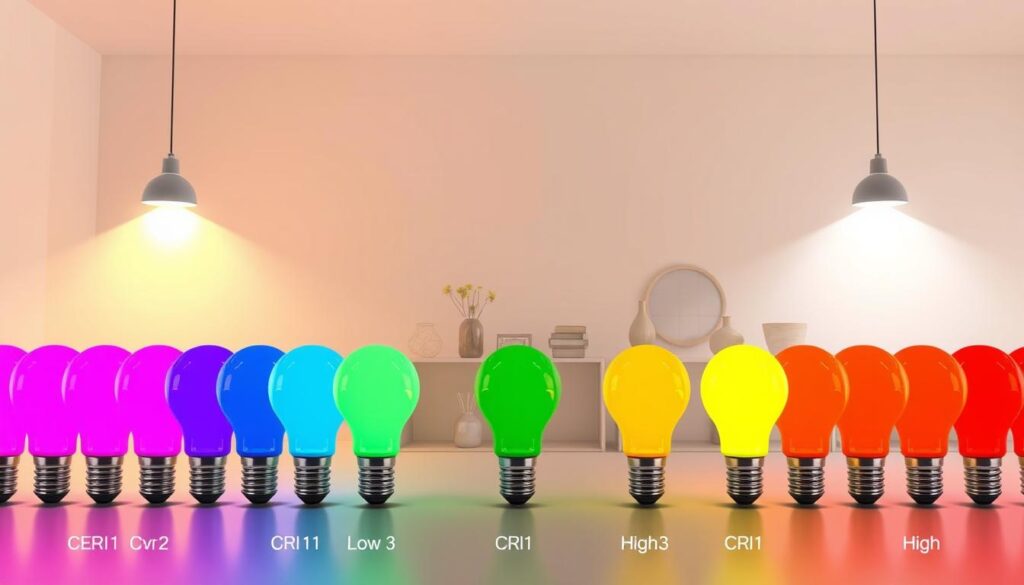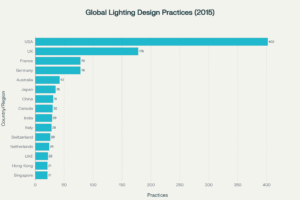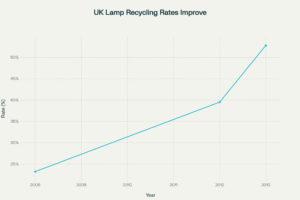At Lumenloop, we recognise that the colour rendering index (CRI) stands as a critical factor in determining light quality for professional lighting solutions. Many of our high-performance luminaires have optional high CRI upgrades.
The colour rendering index is a measurement that reveals how accurately a light source displays colours compared to natural light. When selecting lighting for commercial, industrial, or retail environments, understanding CRI becomes paramount for creating optimal visual experiences.
Professionals in facility management, electrical engineering, and lighting design depend on precise colour rendering to ensure visual comfort and accuracy. A high CRI rating indicates that the light source will reveal colours with remarkable fidelity, making it essential for spaces where colour perception matters.
Different light sources produce varying levels of colour rendering performance. LED lighting technology has revolutionised our ability to achieve superior CRI ratings, enabling more realistic and vibrant illumination across diverse applications.
We are committed to developing luminaires that not only meet but exceed industry standards for colour rendering, supporting our mission to create sustainable and regenerative lighting solutions for the future.
What is Colour Rendering Index Explained: A Comprehensive Guide
Understanding the Colour Rendering Index (CRI) is crucial for anyone working with light fixtures and bulbs. At Lumenloop, we recognise that CRI represents a vital metric in evaluating light quality across various environments.
CRI measures how accurately a light source reveals the true colours of an object compared to natural light. The scale ranges from 0 to 100, with higher numbers indicating superior colour rendering capabilities.
The Science Behind CRI Measurements
CRI calculations involve complex scientific processes that assess how different light sources illuminate eight standard colour samples. LED bulbs and other light sources are evaluated based on their ability to reproduce colours authentically.
- Standard reference light sources include incandescent and natural daylight
- Measurements compare the colours rendered under test and reference illumination
- Higher CRI values indicate more accurate colour representation
How CRI Affects Light Quality
The colour temperature and CRI of light fixtures significantly impact visual perception. A high CRI light source, such as our LED bulbs with a CRI of 90, ensures that colours appear vibrant and true to life.
| Light Source | Typical CRI | Colour Rendering Quality |
|---|---|---|
| Incandescent | 99-100 | Excellent |
| Fluorescent | 50-80 | Average |
| LED | 70-95 | Good to Excellent |
The CRI Scale: From 0 to 100
Our energy-efficient LED technology enables high CRI performance across various applications. The scale provides critical insights into light quality:
- 0-55 CRI: Poor colour rendering
- 56-75 CRI: Fair colour rendering
- 76-90 CRI: Good colour rendering
- 90-100 CRI: Excellent colour rendering

By understanding CRI, professionals can select optimal lighting solutions that enhance visual clarity and colour accuracy across diverse settings.
The Impact of CRI on Commercial and Industrial Lighting
Colour Rendering Index (CRI) plays a critical role in transforming lighting experiences across various commercial and industrial environments. Our lighting design approach recognises that the ability of a light source to reveal true colours directly impacts performance, safety, and visual perception.
Understanding CRI values helps organisations select optimal lighting solutions that enhance workspace functionality and aesthetic appeal. We explore how different sectors leverage colour quality to achieve remarkable results.
Applications in Retail and Display Lighting
In retail environments, accurate colour rendering becomes paramount. A high CRI of 80 or 100 ensures:
- Precise product colour representation
- Enhanced customer engagement
- Improved visual merchandising
LED strip lights with superior CRI values transform display spaces, making colour samples appear vibrant and authentic compared to traditional incandescent and halogen light sources.
Industrial Settings and Workspace Requirements
Industrial lighting demands precision. Our expertise demonstrates that proper colour rendering significantly impacts workplace safety and productivity.
| CRI Range | Workplace Impact |
|---|---|
| CRI 70-79 | Basic visual recognition |
| CRI 80-90 | Enhanced detail perception |
| CRI 90-100 | Exceptional colour accuracy |
Healthcare and Educational Facility Considerations
Lighting education extends beyond mere illumination. Critical environments like healthcare facilities and educational institutions require meticulous colour rendering. High CRI lighting supports:
- Precise medical diagnostics
- Improved learning environments
- Reduced eye strain
By carefully selecting lighting solutions that measure the ability to render colours accurately, we ensure optimal visual performance across diverse professional settings.
LED Technology and Colour Rendering Performance
LED technology has revolutionised the lighting industry, particularly in colour rendering performance. Our journey at Lumenloop has focused on developing high-quality light sources that accurately reproduce colours with exceptional precision.
Modern LED solutions have dramatically improved from early iterations. The cri light source capabilities now reach impressive levels, particularly when considering the nuanced challenges of colour reproduction. We’ve discovered that achieving a 90 cri rating requires sophisticated engineering.
- Phosphor coating technology influences colour rendering
- Advanced chip design enhances light source accuracy
- Sophisticated driver technology impacts lighting quality
Understanding the cri scale is crucial for selecting optimal lighting. Different light sources perform uniquely – for instance, 5000k LED configurations offer remarkable colour representation compared to traditional incandescent light.
| Light Source | CRI Rating | Colour Accuracy |
|---|---|---|
| Standard LED | 70-80 | Moderate |
| High Performance LED | 90-95 | Excellent |
| Incandescent | 95-100 | Near Perfect |
Our commitment extends beyond technical specifications. We’re dedicated to creating luminaires that not only provide excellent lighting quality but also contribute to our vision of 100% regenerative lighting solutions.
Comparing CRI Across Different Light Sources
Understanding colour rendering index (CRI) is crucial for creating great lighting solutions. As lighting manufacturers, we recognise the intricate nuances that separate exceptional illumination from ordinary light sources.
Natural light remains the gold standard for colour reproduction, with a perfect CRI rating of 100. Artificial light sources strive to replicate this benchmark, with LED technologies making significant strides in recent years.
Natural Light vs Artificial Light Sources
When comparing light sources, we evaluate their ability to accurately reproduce true colours. Daylight colour temperature provides the most authentic representation, while artificial light sources struggle to match this precision.
- Natural light: CRI 100 (Perfect colour rendering)
- Artificial light: CRIs ranging from 75 to 90
- LED technology: Increasingly sophisticated colour reproduction
LED vs Traditional Lighting Technologies
Modern LED solutions now achieve CRI ratings of 80 to 90, significantly outperforming traditional lighting technologies. Lower CRI sources like fluorescent lights often struggle to represent colours accurately.
| Light Source | Average CRI | Colour Reproduction Quality |
|---|---|---|
| Incandescent | 95-100 | Excellent |
| LED | 80-90 | Very Good |
| Fluorescent | 70-80 | Average |
Conclusion
Our journey through Colour Rendering Index (CRI) reveals its critical importance in creating exceptional lighting environments. From retail stores to photography studios, understanding the 0 to 100 spectral measurement helps professionals select the appropriate lighting solutions for diverse spaces. Whether illuminating art galleries or paint shops, the right CRI can dramatically transform visual perception.
At Lumenloop, we recognise that not all lighting performs equally. A luminaire with a low CRI might be considered poor, especially when compared to traditional 2700k incandescent lamp sources. Our commitment extends beyond mere illumination – we aim to create lighting experiences where colours appear different, vibrant, and true to life. We understand that ultraviolet and spectral characteristics play a significant role in how environments are perceived.
Our mission goes beyond manufacturing luminaires. We are dedicated to closing the lighting industry’s sustainability loop, ensuring every product contributes to a regenerative future. By focusing on high-performance solutions that prioritise colour rendering and efficiency, we help professionals make informed decisions that enhance visual environments while reducing environmental impact.
As lighting technology advances, we continue to push boundaries. Understanding CRI is not just about technical specifications – it’s about creating spaces where light transforms experiences, supports human perception, and contributes to more sustainable, responsive built environments.
FAQ
What is Colour Rendering Index (CRI)?
Colour Rendering Index (CRI) is a quantitative measure of a light source’s ability to accurately reproduce the colours of objects compared to natural light. It’s measured on a scale from 0 to 100, with higher scores indicating more accurate colour representation. A CRI of 90 or above is considered excellent, while scores below 80 are generally considered poor in professional lighting applications.
Why is CRI important in lighting design?
CRI is crucial because it directly impacts how colours appear under artificial lighting. In environments like retail stores, art galleries, photography studios, and healthcare facilities, accurate colour rendering is essential for visual tasks, product presentation, and overall visual comfort. A high CRI ensures that colours look natural and true to life, improving the quality of the visual experience.
How does CRI differ from colour temperature?
While colour temperature measures the warmth or coolness of light (measured in Kelvin), CRI measures the light source’s ability to render colours accurately. These are two different aspects of light quality. For example, a light source might have a warm colour temperature of 2700K but a low CRI, meaning it won’t accurately show the true colours of objects.
What CRI rating should I look for in lighting?
For most professional and high-quality applications, we recommend a CRI of 90 or above. Lighting with a CRI of 80 to 90 is generally considered good, while anything below 80 is typically viewed as having poor colour rendering. Critical environments like art galleries, medical facilities, and professional workspaces typically require the highest CRI ratings.
How do LEDs compare to other light sources in terms of CRI?
Modern LED technology has significantly improved CRI performance. While early LEDs struggled with colour rendering, current high-performance LED solutions can now achieve CRI ratings of 90 or higher. Some advanced LED fixtures can even approach the colour rendering capabilities of traditional incandescent and halogen light sources, while offering superior energy efficiency.
Can CRI affect workplace productivity?
Yes, absolutely. Proper colour rendering can significantly impact workplace environments. In industrial settings, accurate colour rendering helps workers distinguish between objects more clearly, potentially improving safety and reducing errors. In office environments, high CRI lighting can reduce eye strain and fatigue, ultimately contributing to better overall workplace productivity and well-being.
How do I measure or verify a light source’s CRI?
CRI is typically measured using standardised colour samples and complex spectral analysis. Professional lighting manufacturers like Lumenloop provide detailed CRI specifications for their products. Look for comprehensive colour rendering reports that include not just the overall CRI rating, but also specific R values, which provide a more detailed breakdown of colour rendering performance across different colour spectrums.
Are there alternative colour rendering metrics?
Yes, while CRI is the most common metric, there are alternative methods like the Colour Quality Scale (CQS) and the newer TM-30 method developed by the Illuminating Engineering Society (IES). These alternative metrics provide more comprehensive assessments of colour rendering, offering additional insights beyond the traditional CRI scale.












